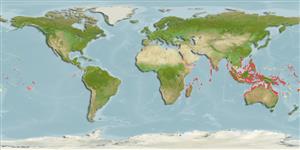Common names from other countries
>
Blenniiformes (Blennies) >
Blenniidae (Combtooth blennies) > Salariinae
Etymology: Cirripectes: Latin, cirrus = curl fringe + Greek, pektos, -e, -on = made of several parts solidly united (Ref. 45335); auritus: Name from Latin 'auritus', meaning 'eared', referring to the earlike nuchal flap on either side of the head..
Environment: milieu / climate zone / depth range / distribution range
Ekologi
marina revassocierade; djupintervall 0 - 20 m (Ref. 630), usually 0 - 10 m (Ref. 529). Tropical; 20°N - 35°S
Indo-West Pacific: Kenya to South Africa, then Similan Islands (Thailand), Philippines and the Line Islands.
Length at first maturity / Size / Vikt / Age
Maturity: Lm ?, range 5 - ? cm
Max length : 7.1 cm SL hane/ej könsbestämd; (Ref. 529)
Taggstrålar i ryggfenan (totalt) : 12 - 13; Mjukstrålar i ryggfenan (totalt) : 15 - 17; Taggstrålar i analfenan: 2; Mjukstrålar i analfenan: 16 - 18; Ryggkotor: 31 - 33. Diagnosis: Dorsal fin XII-XIII, 15-17 (usually XII,17), entire, only slightly or not at all incised above last spine, first spine equal to second; anal fin II, 15-16; pectoral rays 14; pelvic fin I, 4; caudal fin procurrent rays 10-13. Body depth at anal-fin origin 4.8-5.1 in SL. Vertebrae 10 + 21-23; vertebral centrum, last pleural ribs 11-12, last epipleural rib 17-19. Without scales and scalelike flaps. LL tubes 7-12, series ends below dorsal fin rays 5-13. Lower lip smooth mesially, plicate laterally. Upper lip crenulae 34-39. Gill rakers 21-25. Cirri, nuchal 22-34, supraorbital 2-7, nasal 4-6. Nuchal cirri minute, 5-8 independently distributed, in 2 greatly expanded flaps on each side of nape. Nuchal flaps black. Inner ring of iris yellow, outer ring reddish brown. Body coloration of adults variable (varies in different areas and may also vary between sexes); may be pale, brown, or mottled pale and brown background but always with tiny dark spots on posterior 1/2 to 3/4 of the body and with pale spots or streaks from orbit to upper lip. Similan and Fanning Islands females head mottled strongly with reddish-brown and pinkish-white spots and streaks, body with broad irregular brown bars; in Fanning Islands the pale areas in the head are all faint pink and interspaces on body are cream or light brown instead of faint pink as in those from Similan Islands. Males in Fanning I. are also mottled but in Indian Ocean only females are mottled. Philippines female has uniformly dark brown color. South African males with darker cirri than those from other localities. Meristic and morphometric patterns does not vary geographically. Body depth at anal fin origin 4.8-5.1 in SL (Ref. 529, 90102). Ophioblennius stage overall cream; mouth area without spots; cirri and nuchal flap pale; fins transluscent (in alcohol); with 2 canines on each dentary, posteriorly (Ref. 529). (Ref. 529).
Facultative air-breathing in the genus (Ref. 126274); Found on coral rocks, some on sandy bottom in water about 5 m deep or on irregular rocky bottom with sparse live coral and no sand (Ref. 630). Also in shallow protected reefs with rich coral and algae growth, usually found at depths less than about 10 m; occasionally deeper. Usually seen solitary (Ref. 48636). One specimen taken from 20 m in the Comoro Island. Oviparous. Eggs are demersal and adhesive (Ref. 205), and are attached to the substrate via a filamentous, adhesive pad or pedestal (Ref. 94114). Larvae are planktonic, often found in shallow, coastal waters (Ref. 94114).
Oviparous, distinct pairing (Ref. 205). Urogenital orifice of male genital papilla located basally between 2 widely separated slender filaments on a fleshy swelling behind anus; testes bulbous with length equal to width (Ref. 529).
Williams, J.T., 1988. Revision and phylogenetic relationships of the blenniid fish genus Cirripectes. Indo-Pac. Fish. (17):78 p. (Ref. 529)
IUCN Red List Status (Ref. 130435)
CITES (Ref. 128078)
Not Evaluated
Threat to humans
Harmless
Human uses
Fiskeri: saknar intresse
Verktyg
Special reports
Download XML
Internet-källor
Estimates based on models
Preferred temperature (Ref.
115969): 25.4 - 29.3, mean 28.5 (based on 2513 cells).
Phylogenetic diversity index (Ref.
82804): PD
50 = 0.5000 [Uniqueness, from 0.5 = low to 2.0 = high].
Bayesian length-weight: a=0.00741 (0.00335 - 0.01640), b=3.02 (2.83 - 3.21), in cm Total Length, based on LWR estimates for this (Sub)family-body shape (Ref.
93245).
Trofisk nivå (Ref.
69278): 2.0 ±0.00 se; based on food items.
Resiliens (Ref.
120179): Hög, lägsta populationsfördubblingstid mindre än 15 månader (Preliminary K or Fecundity.).
Fishing Vulnerability (Ref.
59153): Low vulnerability (10 of 100).
